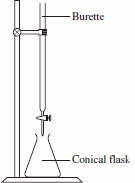- What are you being asked to do?
Determine the concentration of hypochlorite ions in mol L-1 in bleach
c(ClO-) = ? mol L-1
- What information (data) have you been given in the question?
V(bleach) = volume of bleach = 20.00 mL = 20.00/1000 = 0.02000 L
n(I-) = moles iodide to react with hypochlorite in bleach = excess mol
c(S2O32-) = concentration of thiosulfate solution = 1.950 mol L-1
V(S2O32-) volume of thiosulfate solution used in titration = 12.58 mL = 12.58/1000 = 0.01258 L
- What is the relationship between what you know and what you need to find out?
Reaction 1: hypochlorite reacts with excess iodide to produce iodine:
| hypochlorite |
|
iodide |
|
|
|
iodine |
|
chloride |
|
|
| ClO-(aq) |
+ |
2I-(aq) |
+ |
2H+(aq) |
→ |
I2(aq) |
+ |
Cl-(aq) |
+ |
H2O(l) |
| faintly yellow |
|
colourless |
|
|
|
brown |
|
colourless |
|
colourless |
n(ClO-) = n(I2)
Reaction 2: titration of iodine produced in reaction 1 with standardised aqueous sodium thiosulfate solution:
| thiosulfate |
+ |
iodine |
→ |
iodide |
+ |
dithionate |
| 2S2O32-(aq) |
+ |
I2(aq) |
→ |
2I-(aq) |
+ |
S4O62-(aq) |
n moles thiosulfate, S2O32-, reacts with ½ x n moles iodine, I2
n(I2) = ½ x n(S2O32-)
and n(S2O32-) = c(S2O32-) x V(S2O32-)
therefore n(I2) = ½ x c(S2O32-) x V(S2O32-)
Since n(ClO-) = n(I2) = ½ x c(S2O32-) x V(S2O32-)
and c(ClO-) = n(ClO-) ÷ V(ClO-)
it follows that
| c(ClO-) = |
| ½ x c(S2O32-) x V(S2O32-) |
|
| V(ClO-) |
- Calculate the concentration of ClO- in the bleach:
| c(ClO-) |
= |
½ x c(S2O32-) x V(S2O32-) |
|
| V(ClO-) |
| |
= |
½ x 1.950 x 0.01258 |
|
| 0.02000 |
| c(ClO-) |
= |
0.6133 mol L-1 |
- Is your answer plausible?
Check your calculations: use your calculated concentration of ClO- to calculate how much S2O32- would be required in the titration.
n(ClO-) = c(ClO-) x V(ClO-) = 0.6133 x 20.00/1000 = 0.012266 mol
and n(I2) = n(ClO-) = 0.012266 mol
n(S2O32-) used in titration = 2 x n(I2) = 2 x 0.012266 = 0.024532 mol
volume of S2O32- titre = n(S2O32-) ÷ V(S2O32-) = 0.024532 ÷ 1.95 = 0.01258 L = 12.58 mL
Since this volume is the same as that given in the question, we feel confident that the concentration of ClO- in the bleach is 0.6133 mol L-1.
Have we answered the question that was asked?
Yes, we have determined the concentration of hypochlorite ions in bleach in mol L-1.
- State the solution to the problem:
The concentration of hypochlorite ions in the bleach solution is 0.6133 mol L-1
1. The equations given here are a simplification of the reactions that occur.
In the first step, sodium hypochlorite, NaClO, and acid, H
+(aq), react to produce hypochlorous acid, HOCl(aq).
Hypochlorous acid reacts with iodide under acidic conditions to produce the triiodide ion, I
3-(aq):
ClO
-(aq) + 3I
-(aq) + 2H
+(aq) → Cl
-(aq) + I
3-(aq) + H
2O
Triiodide is a dark red complex.
When combined with starch, triiodide forms a dark blue complex
I
3- + starch → [I
3-][starch]
The starch-triiodide complex is titrated with sodium thiosulfate to produce a colourless solution of iodide, dithionate, and uncomplexed starch:
[I
3-][starch] + 2S
2O
32- → 3I
- + S
4O
62- + starch
2. Starch should be added just before the end point of the titration, not earlier.
If the starch is added too early, when the iodine concentration is still high, the slow dissociation of the starch-iodine complex results in a diffuse end point.
The acidic conditions necessary to promote the reaction between oxidizing agents and iodide, also promote the hydrolysis of starch which destroy its indicator qualities, so the starch should be added as late as possible in the procedure.
3. Acidified potassium iodide solution is prepared by adding 14.0 g potassium iodide and 40 mL of glacial acetic acid to a 1 L volumetric flask and making up to the mark with water.


